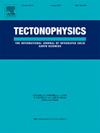Constraining the slip history of the Katschberg normal fault (Eastern Tauern Window) by thermo-kinematic modeling: Implications for the tectonic evolution of the Eastern European Alps in the late Cenozoic
IF 2.6
3区 地球科学
Q2 GEOCHEMISTRY & GEOPHYSICS
引用次数: 0
Abstract
The Katschberg normal fault borders the Tauern Window to the east and played a crucial role during Miocene lateral tectonic extrusion in the Eastern European Alps. In this study, we present new cooling ages from low-temperature thermochronology as well as thermo-kinematic models, which constrain the exhumation history of the Penninic units in the footwall of the Katschberg normal fault and its slip history. Zircon and apatite fission track and apatite (U–Th)/He ages from footwall units range from 16.0 ± 1.9 Ma to 12.8 ± 1.4 Ma, 10.4 ± 1.8 Ma to 7.9 ± 1.3 Ma and 8.2 ± 0.8 Ma to 3.9 ± 0.4 Ma, respectively. Thermo-kinematic modeling indicates that the Katschberg normal fault was active between 21.1 ± 1.8 Ma and 12.2 ± 1.3 Ma and accommodated 27 ± 6 km of crustal extension at a total rate of 3.5 ± 0.3 km/Myr. After the end of normal faulting, exhumation continued with a rate of 0.21 ± 0.06 km/Myr until 2.0 ± 0.5 Ma and with a rate of 0.84 ± 0.08 km/Myr until present. A comparison with another Miocene low-angle normal fault in the Eastern Alps – the Brenner fault – reveals that the amount of extension accommodated by these faults decreases from west to east, which is consistent with an eastward decrease in N-S shortening. Therefore, Miocene deformation is greatest in the western Tauern Window near the Brenner normal fault where shortening in front of the Adriatic Indenter is at its maximum.
通过热运动学建模确定 Katschberg 正断层(东陶恩窗)的滑动历史:对晚新生代东欧阿尔卑斯山构造演化的影响
卡茨贝格正断层在东面与陶恩窗接壤,在东欧阿尔卑斯山中新世横向构造挤压过程中发挥了至关重要的作用。在这项研究中,我们通过低温热震学以及热运动学模型,提出了新的冷却年龄,从而对卡茨贝格正断层脚墙彭尼尼单元的出露历史及其滑动历史进行了约束。脚墙单元的锆石和磷灰石裂变轨迹和磷灰石(U-Th)/He年龄分别为 16.0 ± 1.9 Ma 至 12.8 ± 1.4 Ma、10.4 ± 1.8 Ma 至 7.9 ± 1.3 Ma 和 8.2 ± 0.8 Ma 至 3.9 ± 0.4 Ma。热运动学模型显示,卡茨贝格正断层在 21.1 ± 1.8 Ma 至 12.2 ± 1.3 Ma 期间处于活跃状态,并以 3.5 ± 0.3 km/Myr 的总速率容纳了 27 ± 6 km 的地壳延伸。正断层结束后,地壳继续以0.21 ± 0.06 km/Myr的速度隆起,直到2.0 ± 0.5 Ma,直到现在,隆起速度为0.84 ± 0.08 km/Myr。与东阿尔卑斯山的另一个中新世低角度正断层--布伦纳断层--的比较显示,这些断层所容纳的延伸量自西向东递减,这与北南缩短的东向递减相一致。因此,在布伦纳正断层附近的陶恩窗西部,中新世时期的变形最大,那里亚得里亚海肠前的缩短达到最大程度。
本文章由计算机程序翻译,如有差异,请以英文原文为准。
求助全文
约1分钟内获得全文
求助全文
来源期刊

Tectonophysics
地学-地球化学与地球物理
CiteScore
4.90
自引率
6.90%
发文量
300
审稿时长
6 months
期刊介绍:
The prime focus of Tectonophysics will be high-impact original research and reviews in the fields of kinematics, structure, composition, and dynamics of the solid arth at all scales. Tectonophysics particularly encourages submission of papers based on the integration of a multitude of geophysical, geological, geochemical, geodynamic, and geotectonic methods
 求助内容:
求助内容: 应助结果提醒方式:
应助结果提醒方式:


